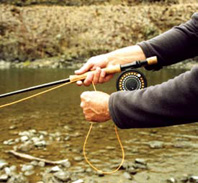Retrieves

A broad range of retrieves is needed to simulate the natural motions of aquatic foods. Insects possess a variety of means of locomotion. Some foods move slowly while others are much faster. Likewise, aquatic insects display a wide variance in their motions.
A fish is fooled when a fly both looks and acts lifelike. The importance of the correct retrieve which simulates the natural motions of the insect coupled with a fly pattern matching color, size, shape, and silhouette of the insect will be deadly.
Most of the time in lake fishing the goal is to present the fly just above the bottom. This is achieved by taking into account the line’s sink rate, suspension depth, and allotted sinking time. Adjust these factors to place the fly precisely at the optimal depth.
The retrieve is accomplished by a combination of rod and line hand movements. The basic hand position prepares you to both properly retrieve the fly and to battle the fish. The hook set and fight take place immediately during the retrieve. The basic rod hand position when rod movement is not part of the retrieve is as follows: The rod hand grasps the cork grip in the normal casting position with the thumb extended on top of the cork and the index finger directly below it. Either the index or the middle finger controls the line by acting as a guide and a brake that can pinch off the line against the cork. I prefer the middle finger to act as the line guide and brake because it leaves the thumb and index finger in control of a firm rod grip. Additionally, the ring finger can assist in pressing the line against the grip. By applying slight finger pressure, a line drag can be instantly applied and adjusted. The line finger plays a role in both fighting a fish and making the retrieve. With much practice this line finger can become proficient as an instant judge of drag tension. Most of the time, I employ the lightest drag pressure setting on my reel (just light enough to prevent a spool overrun). Next, I rely upon my fingers to apply additional pressure to the line and reel spool. This gives me an instant feel for what an unpredictable fish is doing. The finger drag control is useful in nearly all freshwater angling.
A retrieve’s basic rod position is to point the rod downwards toward the line and the fly. The rod tip can be submerged.
The basic retrieves are the strip, pull, and hand twist. Each will be discussed.


© 2025 The Gale Group, Inc. All rights reserved.
© 2025 Perigee Learning LLC. All rights reserved.
LoveTheOutdoors.com is owned and operated by Advameg, Inc. © 2025 Advameg, Inc.
Camping Adventures • Dutch Oven Cooking • Sports Knots
Fly Tying • Freshwater Fishing • Fly Fishing

